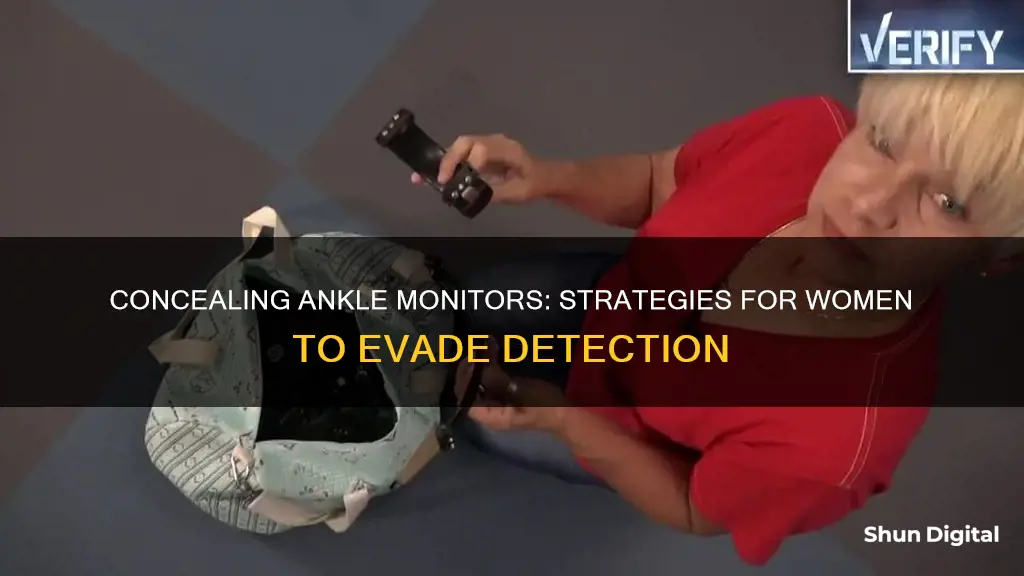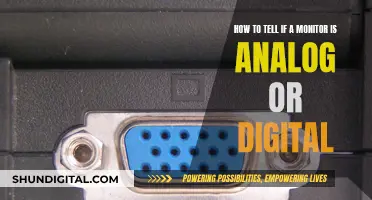
Women have a variety of options for hiding an ankle monitor, ranging from specific clothing choices to using a cover. While the bulky, black, rectangular design of ankle monitors makes them challenging to conceal, wearing flared or bootcut jeans can provide extra space around the ankle to hide the device. Additionally, wearing tall socks or boots can also help to cover the monitor. For a more temporary solution, some women opt to use an ankle monitor cover that disguises the device as a regular ankle brace. This can be especially useful when wearing shorter pants that may ride up and expose the monitor. It's important to note that while these methods can minimize the visual impact of the monitor, they may not completely disguise it, and there is still a risk of drawing attention or causing discomfort.
| Characteristics | Values |
|---|---|
| Size of ankle monitor | 4 to 8 cubic inches |
| Location of ankle monitor | Ankles are often exposed |
| Shape of ankle monitor | Rectangular |
| Colour of ankle monitor | Black |
| Fit of ankle monitor | A gap between the device and the skin allows for movement |
| Material of ankle monitor | Plastic |
| Methods of hiding | Top-down approach (e.g. long pants), bottom-up approach (e.g. socks, boots), cover-over (e.g. medical tools, workout gear, cast, bandage) |
| Tools for hiding | Aid Loop |
| Types of pants | Flared/bootcut jeans, Bohemian/Harem/Boho pants, wide-leg pants, joggers, straight-leg denim, sweatpants, bell bottoms |
| Types of shoes | Work boots |
What You'll Learn

Wear long, wide-leg pants
If you want to hide an ankle monitor, wearing long, wide-leg pants is a good option. The top-down approach, where you wear pants that cover below the knee, is one of the main ways to hide an ankle monitor. To ensure the ankle monitor is not exposed from underneath, the pants should be extra long and reach the bottom of the ankle. Be cautious when sitting or going up stairs, as this can cause the monitor to become visible.
With the current trend of wide and baggy pants, it should be easy to find a style that covers your ankle monitor. Try a 90's style wide-leg pant or a loose jogger. Avoid anything skin-tight or exposed.
When wearing wide-leg pants, consider the type of shoe you pair them with. A wider-leg jean typically looks better with a chunkier shoe, such as a thick trainer or work boot.
In addition to providing coverage, long, wide-leg pants can also increase comfort. Ankle monitors can cause chafing and discomfort, so wearing loose-fitting pants can help alleviate this issue.
Remember, while hiding an ankle monitor can give you privacy, it's important to follow any legal requirements and restrictions regarding the monitor.
Diagnosing Lexus RX350 Blind Spot Monitor: Step-by-Step Guide
You may want to see also

Use an ankle monitor cover
Ankle monitor covers are designed to look like a regular ankle brace, offering privacy and comfort to the wearer. They are made from ultra-soft neoprene with two elastic hook and loop straps to keep the monitor securely in place while ensuring all-day comfort. The clever design keeps the device centred on your leg, helping to prevent rubbing or chafing during physical activity or even just walking around.
The market offers a variety of ankle monitor covers, with some designed for specific purposes. For instance, the Ankle Monitor Guard (AMG) is a lightweight, water-resistant cover for standard-sized ankle monitors. It is constructed from durable neoprene with flexible nylon straps for a secure fit, though it is not intended for prolonged use in water.
Another option is the MAXTEQ USA Ankle Monitor Cover, which features adjustable elastic straps and stretchy neoprene for a comfortable and secure fit. This product is also ultra-discrete, with no logos or identifying marks.
Ankle monitor covers can be purchased from various online retailers, such as Amazon, and typically range in price from $20 to $30.
While ankle monitor covers can provide privacy and comfort, it is important to note that they may not completely disguise the monitor. Additionally, some users have reported issues with the fit of these covers, so it is recommended to try different styles and shoes with the monitor in place to ensure a proper fit.
Lexus NX: Blind Spot Monitor Availability and Performance
You may want to see also

Wear a fracture boot
If you're looking to hide an ankle monitor, one approach is to disguise it as a medical device, such as a fracture boot. Here's a guide on how to wear a fracture boot to effectively hide your ankle monitor:
Choosing the Right Boot
Select a walking boot, which is a type of medical shoe designed to protect and stabilise your foot and ankle after an injury or surgery. These boots are commonly used for broken bones, tendon injuries, severe sprains, or shin splints. The boot should have between 2 and 5 adjustable straps and reach mid-way up your calf. Ensure the boot is the correct size for your foot and calf, as an improper fit can cause discomfort and pressure on your skin.
Putting on the Boot
Sit down and place your heel all the way to the back of the boot. This ensures your foot is in the correct position within the boot. Then, wrap the soft liner, which comes with the boot, around your foot and leg. This liner provides a layer of protection and comfort. Next, place the front piece of the boot over the liner.
Fastening the Straps
Begin fastening the straps closest to your toes and gradually move up your leg. It's important to tighten the straps securely, but not excessively. The boot should restrict the movement of your ankle to aid in healing, but it's crucial that it doesn't cut off your blood flow. If your boot has air chambers, inflate them as instructed by your healthcare provider.
Testing and Adjusting
Stand up and take a few steps to get a feel for walking in the boot. You may need to adjust the straps or air chambers to achieve optimal comfort and support. Remember, you can always loosen the straps or deflate the air chambers if you experience any discomfort, redness, swelling, or numbness in your foot or toes.
Maintenance and Care
To maintain proper hygiene, regularly wash the liner and plastic parts of the boot. Hand-wash the liner with cold water and a mild detergent, and clean the plastic components with a damp cloth and mild soap. When drying the liner, lay it flat. Additionally, keep an eye on your foot and toes, checking for any signs of redness or swelling.
Walking and Rehabilitation
While wearing the boot, be cautious when walking on wet surfaces as the boot may become slippery. You may find it more comfortable to walk on your heel, especially during the initial stages of your recovery. The boot provides stability and comfort, but it's not mandatory to wear it at all times. You can remove it when resting or sleeping, and you may choose to take it off for longer walks or more strenuous activities.
Remember, this guide is intended to provide instructions on properly wearing a fracture boot to disguise an ankle monitor. It's important to be mindful of any legal implications and to comply with the terms of your ankle monitor usage.
Removing Unmonitored MySQL Instances: A Comprehensive Guide
You may want to see also

Wear a long sock underneath the monitor
If you're looking to hide an ankle monitor, one common method is to wear a long sock underneath the monitor. This is known as the "bottom-up" approach, which involves covering the ankle monitor from below. While wearing socks over the monitor can provide coverage, the bulky shape underneath the fabric may still be noticeable. To mitigate this, try folding the sock near the ankle and resting the monitor on top. This will help to stabilize the monitor and prevent it from slipping down.
When selecting socks for this purpose, opt for tall or long socks that reach up to your ankles. This ensures that the monitor is completely covered. Additionally, consider the colour and texture of the socks. Choose socks that match your skin tone or the colour of your pants to minimize attention. Smooth and thin fabrics can help create a sleek appearance, reducing the visibility of any lumps or bumps.
It's important to note that while this method can provide some coverage, it may not be as effective as other approaches. The bulkiness of the monitor can still be noticeable, especially if it shifts during movement. Additionally, wearing thick socks underneath the monitor may increase your foot's overall volume, requiring you to adjust your shoe size accordingly.
Remember, the goal is to discreetly cover the monitor without drawing attention. Ensure that your choice of socks and footwear aligns with the weather, your personal style, and the context of your daily activities. By combining this technique with other strategies, such as wearing loose-fitting pants or boots, you can further enhance the concealment of your ankle monitor.
The Best Places to Buy Fone Monitor
You may want to see also

Wear a cast or bandage
If you want to hide an ankle monitor, one approach is to use a cover-over, which involves attaching or wrapping a layer over the device. For this, you can use medical tools and workout gear meant for the ankles, such as a cast or a bandage.
A cast shell can be placed over the ankle monitor, acting as a perfect camouflage due to its thick layer that prevents movement. This way, no one will know what's underneath. However, a cast will likely enhance attention rather than minimize it, and you may need to explain the imaginary injury and walk with a faux limp.
Bandages can also be used to cover the ankle monitor, creating the appearance of an injury. This method was suggested by a user on Reddit, who also mentioned that wearing flared pants over the monitor was effective in hiding it without the need for bandages.
If you choose to use a cast or bandage to hide your ankle monitor, be aware that this may draw more attention to your ankle, and you may need to fabricate an injury story to explain the situation to friends and family.
Finding the Perfect LCD Monitor: Understanding Screen Sizes
You may want to see also
Frequently asked questions
There are several ways to hide an ankle monitor. You can try wearing flared or bootcut jeans, or a style of pants known as Bohemian, Harem, or Boho, which have extra wide leggings and tight ankle cuffs. You can also try wearing tall boots, or a fracture boot, or using an ankle monitor cover, which is designed to look like a regular ankle brace.
Ankle monitors are large, with sizes ranging from 4 to 8 cubic inches, not including the band. They are also usually black, which can be noticeable from a distance, especially against lighter skin tones. The rectangular shape and bulkiness of the monitor can make it difficult to hide, and the device can move around, causing eye-catching spins and vertical shakes.
Try to wear long, loose-fitting pants, such as wide-leg pants or joggers. Avoid anything skin-tight or exposed. You can also try wearing an ankle brace or a long sock underneath the monitor, and then rolling the sock over the top to cover the plastic.
Be mindful of the type of shoes you wear with wider-leg pants, as they often require a chunkier shoe. Additionally, be cautious when sitting or going up stairs to avoid your pants riding up and exposing the monitor.







